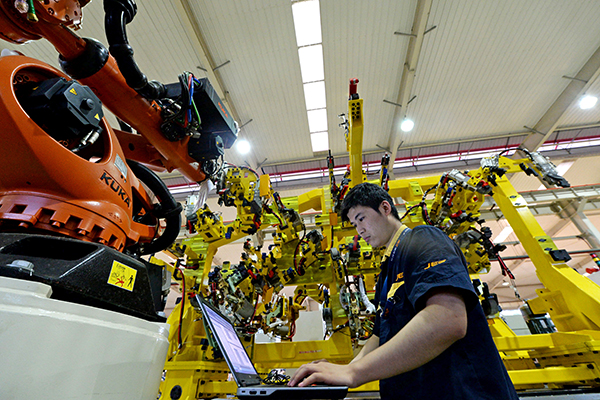Losses from flight of manufacturing have to be offset
Updated: 2016-07-28 07:56
By Xin Zhiming(China Daily)
|
|||||||||
 |
|
A technician writes the program for a robot bound for export in Hefei, capital of Anhui province. [Photo provided to China Daily] |
About 30 years ago, the center of global manufacturing started moving from the West to Asia, most noticeably to China. Now the pendulum has started swinging in the other direction, to Western Europe and the United States, with sports goods giant Adidas announcing it will establish new factories in Germany and the US.
The possibility of manufacturing flowing from China to the West has been in discussion for some years now but few seem to have taken it seriously, with most Chinese dismissing it as a false alarm. Well, the alarm was not false.
Adidas CEO Herbert Hainer recently told the Nikkei Asian Review that the company will soon open a factory in Germany to meet the additional market demand for its shoes and set up another in the US next year. Automation and 3D printing technologies will greatly lower the cost of labor in the relatively expensive Western countries, he said, and thus make the shift worthwhile.
Adidas' new strategy should set off alarm bells for China as the global technology revolution has made possible what used to be impossible even till recently. The cost of labor in China is low, which, along with its competitive preferential policies for foreign investors and a huge consumer market, has created the illusion for many that it is almost impossible for global investors to shift their production bases to the advanced economies where production costs are relatively high.
Indeed, manufacturing has been shifting out of China to countries such as Vietnam and Cambodia, but it mostly involves low-end products that possibly will have little impact on China's manufacturing viability.
But the fast advancement of technologies, spearheaded by automation technologies, will make it possible for manufacturers to greatly reduce the cost of labor in advanced countries. And similar moves by companies like Adidas will have a greater impact on China's competitiveness in the coming years. Therefore, China must be fully prepared for the possible change in the global industrial landscape.
Although Hainer said Adidas would maintain the existing production volume in China, the shifting of the company's additional capacity to Europe and the US will deprive China of the benefits from the continual expansion of the sports goods giant. China, therefore, must find ways to fill the gap left by the flight of manufacturing.
As the world's second-largest economy and the most populous country with a growing middle class, China's vast consumer market means it will remain the center of global manufacturing for quite a long time. Hainer's admission that he still sees "huge potential in China" adds credence to that fact.
Still, China needs to intensify its technological preparedness to embrace the next industrial revolution. For example, it is already home to a number of industrial robot manufacturers, but they lag behind the world leaders in the sector.
China's supportive policies such as higher inputs in research and development, and tax cuts for high-tech enterprises have helped a number of major techcompanies to wield global influence. But its overall technological competitiveness remains weak compared with the advanced economies.
The government's "Made in China 2025" plan is just right to transform the country into a major global manufacturing power with a technological competitive edge. The government has also emphasized the role of innovation, including technological innovation, in driving economic growth. Also, China now has a competitive edge in fields such as nano materials, clean energy, and high-speed trains. If it can stick to its policy of prioritizing high-tech and innovation, more Chinese enterprises will become globally competitive and thus offset the impact of the possible flight of high-end manufacturing from the country.
The author is a senior writer with China Daily.
xinzhiming@chinadaily.com.cn
Related Stories
Guangzhou company to invest 16b in Xinjiang automobile manufacture 2016-06-13 17:24
Top 5 Internet companies planning to manufacture cars 2015-03-16 07:38
China continues support for high-tech manufacturing: Official 2016-07-26 15:24
New life for manufacturing monument 2016-07-18 09:41
Shanxi releases plans for emerging manufacturing industry 2016-07-12 11:18
Foreign experts appointed to improve intelligent manufacturing 2016-07-08 14:47
Today's Top News
No explosion, no injury report in Germany: Police
Geneva airport tightens security after French tipoff
Bill Clinton portrays Hillary as 'change-maker'
Priest, 84, killed in France, attack claimed by IS
Knife attacker in Japan kills 19 at disabled center
Michelle Obama rocks Democratic convention
Syrian suicide bomber in Germany faces deportation
Shooting at Florida nightclub kills, wounds 16
Hot Topics
Lunar probe , China growth forecasts, Emission rules get tougher, China seen through 'colored lens', International board,
Editor's Picks

|

|

|

|

|

|







